
The Shepparton Motor Museum and Collectibles is an automotive enthusiast’s delight with a large collection of vehicles, including classics, muscle cars, and classic muscle cars.
The motor vehicle collection starts with early examples, such as the 1912 Mors Roadster, a manufacturer that started building cars in 1896. It was absorbed into the more recognisable brand, Citroen, by the chairman Andre Citroen.
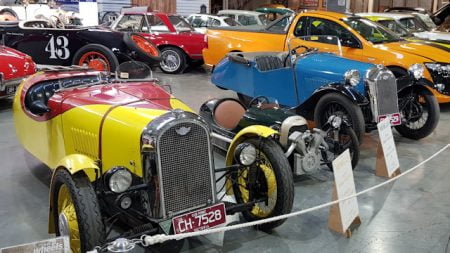
An intriguing inclusion is not one but two Morgan Three Wheelers from 1939, the later F-Series. The three wheeled Reliant Robins are somewhat well known with appearances in shows like Mr Bean and Top Gear and their reputation of tipping over, but these were a new and unique example of three wheeled automobiles that we were not aware of.
Morgan Motor Company started building the Three Wheeler since 1911, originally with a V-twin engine at the front. The modern Morgan Three Wheeler doesn’t look too much different to the F-Series complete with spoked wheels on its sides but has reintroduced the V-twin engine at the front from the earlier model.
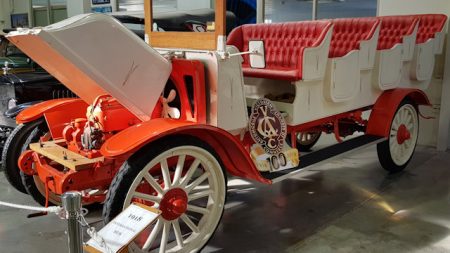
Another unique vehicle in the collection is the 1918 International Bus. It is based on the first truck era of International Harvester Company with a water-cooled upright engine, commonly called the ‘Slope Hood’ IHC trucks because of its slopping hood over the engine. The configuration of the ‘truck’ was built for the purpose, this one putting seating that you would see on a horse-drawn cart or sulky to operate as a bus. The wooden spoke wheels and solid tyres tell the story of early transition of automobiles replacing the horse and cart.
A draw card to motor museums is to see the Australian motoring history and classics from the hey-days of Australian automotive industry. The Shepparton Motor Museum certainly includes this aspect but it also has many other interesting inclusions in the collection.
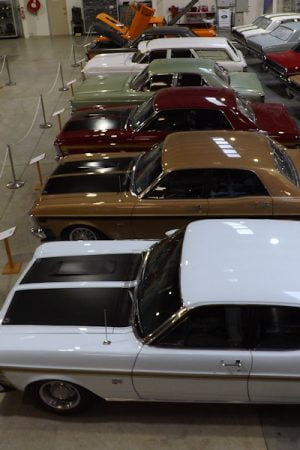
The Volvo P1800 from 1962, used by Roger Moore in the 1960s TV series The Saint is a beautifully designed sports car with the back wings running down the sides of the boot. These Swedish cars were built in England. There is also the 1955 Austin A30, not built in England but right here in Australia with over 220,000 made.
The Australian Muscle Car era started for Ford with the XR Ford Falcon GT. All XR GTs were gold in colour with a genuine and fully restored 1967 example on display. The classic GT Falcons included the XT, XW, and XY models, with the introduction of the XW Falcon GT-HO Phase 1 in 1969 that brought it into iconic status. The museum has a 1970 GT-HO ‘Phase 1.5’ with the updated 351 Cleveland engine (replacing the older 351 Windsor motor).
For Holden, it was the Bathurst winning 1968 Holden HK Monaro GST with a 327 Chevrolet V8. The HK Monaro at Shepparton Motor Museum was bought on the day after Bruce McPhee’s Bathurst win in 1968.
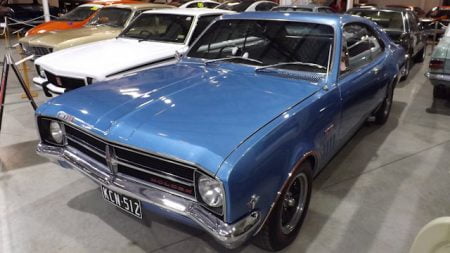
The racing fight between Holden and Ford has remained strong in the Australian culture but have ended with manufacturing ending. Shepparton Motor Museum has one of the last supercharged V8 XR8 Falcons, purchased and registered on the last day of manufacturing by Form Motor Company in Australia on 6ht of October 2016. Sitting beside it is the last non-HSV hot Commodore, the Holden Commodore SSV Redline which was purchased and registered on the last day of manufacturing by General Motors Holden on 20th of October 2017.

There was another Australian in the classic Muscle Car era. The first Chrysler Valiant was built in Australia in 1962, with a 1962 Valiant S on display. It was the introduction of the Chrysler Charger that joined the Holden and Ford muscle car competition. The 1978 Chrysler CL Charger in the collection is the last model of four manufactured by Chrysler Australia, ceasing in August 1978.
There are many other examples in the collection and bound to occupy a good portion on your day for any motoring enthusiast. Once you are done, however, there is more to be seen because the collection is not limited to cars.
Furphy Museum
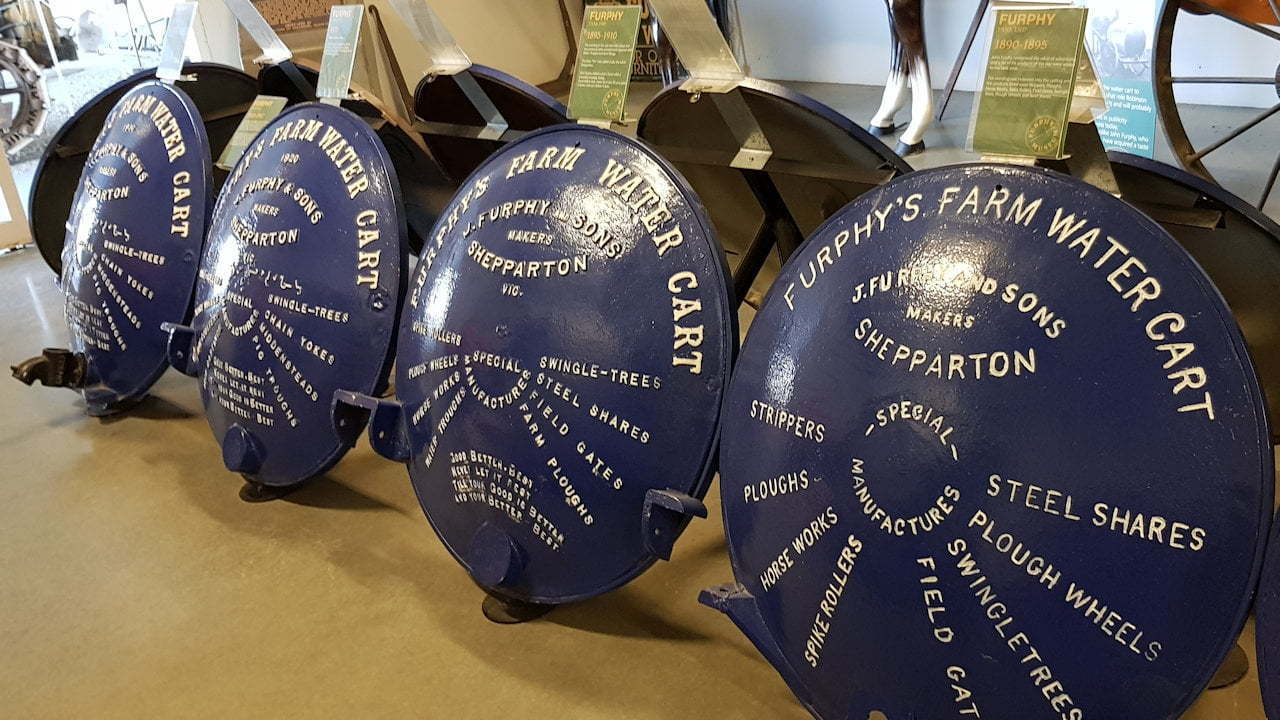
The name is Shepparton Motor Museum and Collectibles, and on the building next to the entry is a large Furphy water tank end that indicates another aspect of the museums collections.
Furphy is an ongoing business in Shepparton, with over 150 years of history starting with John Furphy in a blacksmith and wheelwright business in 1864. Furphy & Sons and the Furphy Foundry are run by 5th generation Furphy descendants.
The most distinctive and known product is the Furphy water cart. It is famous for the cast end plates which had positive messages on them such as “Good – Better – Best. Never let it rest till your good is better and your better is best”. Furphy water carts and water cart end plates are found in many museums, hinting at their popularity in their day.
The Furphy name also become an Australian cultural reference. “Telling a Furphy” is used as a term used for rumours and gossip. The water carts were used during WW1 to cart water to soldiers dug into the trenches. Information and news was slow to reach the front and the drivers of the water carts passed on news to the soldiers from place to place. The news, however, was not often reliable and it became known as telling a Furphy.

The interesting thing about this though is the carts were not Furphy water carts, made by another company and without markings. The name Furphy was strongly associated to water carts so they were simply referred to as Furphy carts anyway.
furphy n.(pl.furphies);
Australian Oxford Paperback Dictionary
1. a false report or rumour; 2. an absurd story
The Furphy Water Cart may be the most well known product made by Furphy, however, there are many other products they built as well with a few varied items on display. Camp ovens, ‘dover stove’ cast iron wood burning stoves, seed broadcaster, grain stripper, and other things.
Farren Bicycle Collection
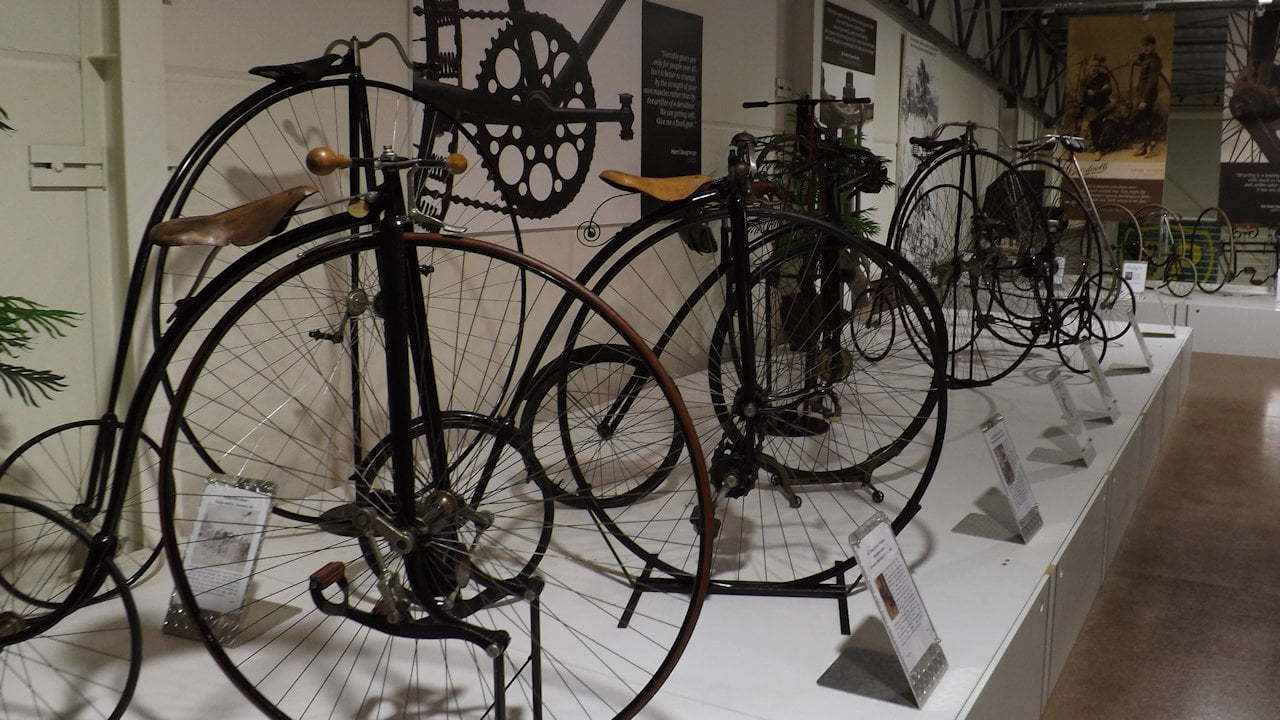
The Farren Bicycle Collection is a large collection of vintage bicycles spanning around 150 years, with the newest from about 1910.
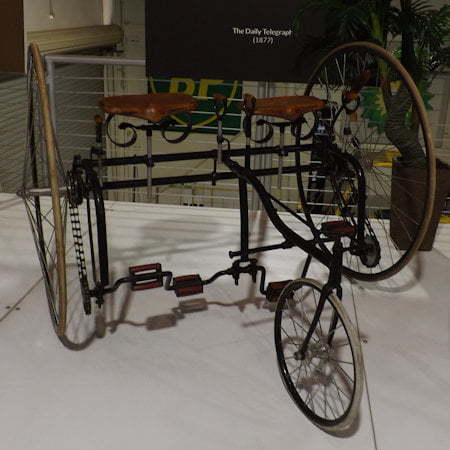
The Shepparton Motor Museum has a rotating display from the collection, including penny farthings, tandem bikes, and side-by-side bikes with two large wheels at the back and a smaller steering wheel at the front.
One of the tricycles with side-by-side seats was chain-driven, each wheel powered independently by each rider. There steering is controlled by the back wheels, so you really need to work as a team to get it to steer correctly. Found in northern NSW, the Wellington Juvenile Sociable Tricycle is very rare, built in 1882 by the Wellington Works in Coventry UK.
The Boneshaker is featured in the collection, invented in the 1860s and regarded by some as the first true bicycle.
As bicycles evolved they were adapted for a variety of purposes. The collection has a number of bikes that show their different uses, whether it was created for the army, for transport of heavy loads, and railway inspection cars. There is also a 1901 bicycle with pedals and chain to the rear wheels and a small combustible engine mounted under the frame.
Not all of the bicycles are vintage. There is a display with replica bikes from arguably one of the best Australian bicycle movies ever made, BMX Bandits. The replicas from the movie release in 1983 that kicked of Nicole Kidman’s movie career, include the Diamond Back Senior Pro, Mongoose Supergoose, and Malvern Star Supermax, all three sporting the plastic spoked BMX wheels that were popular in the 1980s.
To get there:

From the Shepparton Visitor Information Centre, head east along Dixon St (same side from the visitor centre) and take the first right onto Wyndham St, the Goulburn Valley Hwy. Heading south, follow Goulburn Valley Hwy for 6.7km and the Shepparton Motor Museum is on the right.


